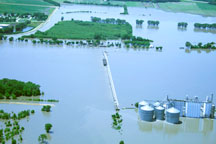Dr. David Casagrande
Midwest floods

Associate Professor of Anthropology
Dept. of Sociology/
Anthropology
and
the Environmental Initiative
STEPS Building, Room 436
Lehigh University
1 West Packer Ave.
Bethlehem, PA 18015
Tel: (610) 758-2672
In 2008 the governor of Illinois requested research on how people were recovering from the Mississippi River floods of that year. My colleague at Western Illinois University (Heather McIlvaine-Newsad) and I obtained a grant from the National Science Foundation to conduct focus groups, interviews and participant observation in rural communities that were flooded. We found that people rely on different social networks for help making decisions, moving items, accessing financial assets, and navigating federal programs (read the final report). Our analysis revealed that different types of social networks are affiliated with different ‘response phases:’ a vital phase, non-vital preparatory phare, non-vital post-impact phase, and a long-term rcovery phase. An individual’s first priority is to protect life and one’s most valuable items, like medication, photographs or irreplaceable personal property. We refer to this as the ‘vital phase.’ After threats to life and valuable items have been addressed, priorities shift to protecting personal structures and community infrastructure in the non-vital preparatory phase. This is a group effort in which social roles and statuses are often suspended in a spirit of communitas. Non-vital post-impact reponses include quickly restoring functionality, salvaging property, or minimizing further loss immediately after disaster. The long-term recovery phase includes regaining financial stability, being reimbursed for expenses, repairing damaged infrastructure, or permanently relocating residences and businesses.
Since 2010, I’ve been collaborating with a team from Western Ilinois University and the University of California, Davis to promote flood disaster mitigation. We were awarded a National Science Foundation grant in 2012 to study impediments to mitigation. Our research indicates that mitigation is most likely to occur soon after a flood, and is most successful when decisions are community-based. Cross-disciplinary collaboration between anthropology, hydrogeology, and planning has allowed us to identify flood-prone locations, key individuals, and intervention strategies that lead to community-based mitigation. We are actively helping communities mitigate as we learn how social relationships affect attitudes and actions. We found that perceptions of risk did not correlate with hydrological or economic risk. Research participants use discursive strategies like social comparison to downplay risk and favor large-scale technological options over difficult household decisions. Many prefer to accept known risk to avoid options like relocation that engender uncertainty.
How my research is funded
Download full CV
 |
|---|
Current Positions
Associate Professor of Anthropology, Lehigh University
Research Coordinator, Environmental Initiative, Lehigh University
Production Editor, Journal of Ecological Anthropology
Topic Editor, Encyclopedia of Earth
Associate Editor, Journal of Ethnobiology and Ethnomedicine
Degrees
Ph.D., University of Georgia, Ecological Anthropology
Master of Forest Science, Yale School of Forestry and Environmental Studies
B.S., Geography, Southern Connecticut State University
Languages
ENGLISH - primary, SPANISH - secondary, TZELTAL (Maya) - intermediate, GERMAN - basic
"Scientists believe in proof without certainty: most people believe in certainty without proof."
Ashley Montagu